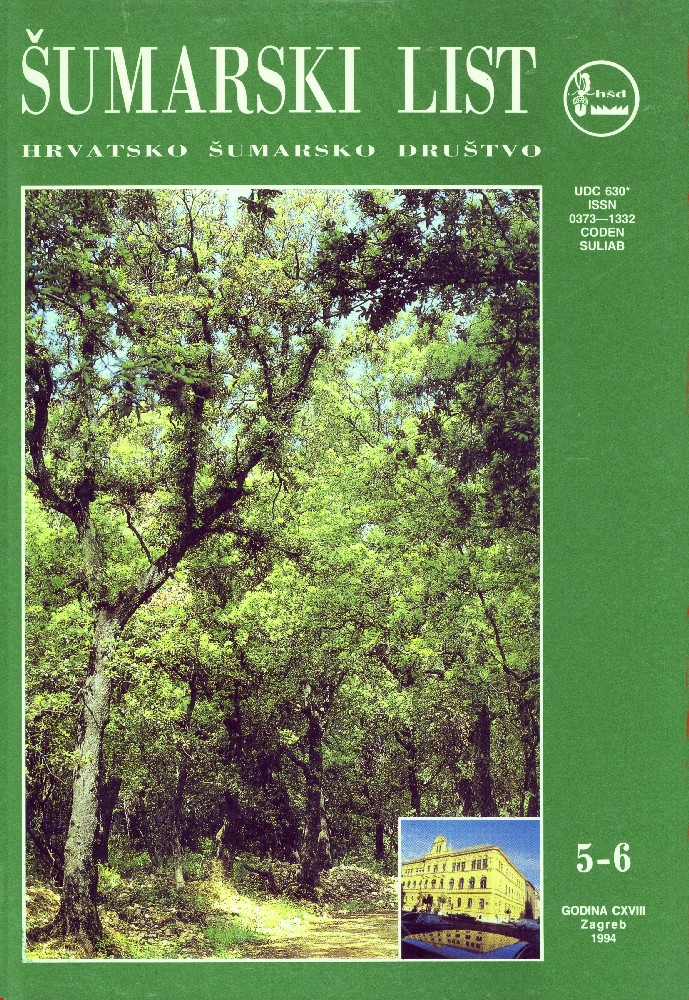
broj: 5-6/1994
pdf (13,3 MB) |
|
||||||||||||||
| IZVORNI ZNANSTVENI ČLANCI | ||
| Orlić, S., Ocvirek, M. | UDK 630* 232.001/2 (Pseudotsuga menziesii (Mirb.) Franco) | |
| Research in Provenanses of Douglas Fir (Pseudotsuga menziesii (Mirb.) Franco) in Croatia pdf HR EN | 139 | |
| Komlenović, N., Krstinić, A. | UDK 630* 161.6 (Populus sec. Aigeiros and Tacamahaca) | |
| Some physiological Characteristic of Croatia Polar Clons of Sections Aigeiros and Tacamahaca pdf HR EN | 147 | |
| Španjol, Ž. i Wolf, S. | UDK 630* + 712 | |
| Biological-Environmental and Space Valorization Park-Forest »Komrčar« on the Island of Rab pdf HR EN | 153 | |
| Huber, D., Radišić, B., Novosel, D., Frković, A. | UDK 591.5 (497.13) (Canis lupus) | |
| Survey of Public Atitude Twords Wolves in Croatia pdf HR EN | 167 | |
| STRUČNI ČLANCI | ||
| Tomašević, A. | UDK 630* 232.216 | |
| Undermining as First Stage of Soil Preparation for Afforestation pdf HR EN | 173 | |
| Summary: The article compares three methods of soil preparation for karst terrain afforestation: — planting under pickaxe (cut-in planting), — planting into holes drilled by »Stihl« 08, and — planting on soil undermined by a ripper. The research resulted in the conslusion that the method of planting into holes drilled bu »Stihl« 08 gave poorest results, and slightly better ones were achieved by planting under pickaxe. The best results were obtained by planting under pickaxe. The best results were obtained by planting on the soil undermined by a ripper. Conclusions: 1. Undermining of soil as a method can be successfully applied at habitat preparations for afforestation of hard karst terrain under unfavourable climate conditions. 2. On karst terrains of categories I, II, III and partly TV tje method of undermining karst terrain can be successfully applied. 3. Underminings of soil, the »furrows«, are made between 50 cm and 100 cm deep, depending on the terrain and engine power. 4. The application of the mechanization for karst afforestation is today indispensable due to requirements for higher performance and humanization of hard labour. 5. It is assumed that costs of undermining by ripper compared to classical karst afforestation methods are lower per suface unit. Live human labour is the most expensive. Ripping as the first phase at habitat preparation in afforestation amounts to 60—80 of total costs, so that in our opinion considerable savings are to be achived here, both in money and time. 6. Undermined surfaces serve as moisture accumulations during rain periods enabling life to plants during dry periods. 7. Plant root systems on ripped terrain penetrate into deeper horizons resulting in faster height increment, which is of great importance for karst conditions. A plant gets more moisture by better penetration, so that it survives summer droughts more successfuly. 8. On undermined soil, survival within first vegetation is more successful than by planting under pickaxe (cut-in planting), and into holes drilled by STIHL 08; the years to follow will either record no mortality at all, or it will be negligable in proportion to the mentioned and other afforestation methods. | ||


